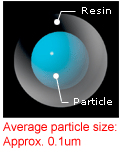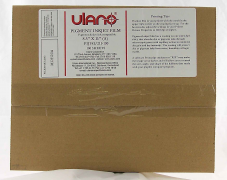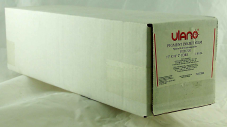Ulano Inkjet Film
InkJet Films for Screen Making
 EPSON inkjet printers can be used as a replacement for a high priced imagesetters and low quality laser printers. Epson's use a room temperature mechanical, piezo technology of precise electrical pulses that cause the ink reservoir wall in the head to compress, projecting ink through the nozzle. Programmers can also control the exact placement, size and shape of each 'dot' then shape with the millions of ink droplets they eject in each square inch. For screen printing, we need a one color printer, not an 8 color printer.RIP programmers can increase ink deposit to make the transparent ink designed for CMYK printing of multi-color photographs, opaque enough to stop UV energy.
EPSON inkjet printers can be used as a replacement for a high priced imagesetters and low quality laser printers. Epson's use a room temperature mechanical, piezo technology of precise electrical pulses that cause the ink reservoir wall in the head to compress, projecting ink through the nozzle. Programmers can also control the exact placement, size and shape of each 'dot' then shape with the millions of ink droplets they eject in each square inch. For screen printing, we need a one color printer, not an 8 color printer.RIP programmers can increase ink deposit to make the transparent ink designed for CMYK printing of multi-color photographs, opaque enough to stop UV energy.
 Canon and HP printers use thermal heads that heat the ink to 500°F over and over, producing a vapor bubble in the ink reservoir (bubble jet). When the ink expands, droplets are ejected through the nozzle. This cannot be increased with a RIP programming. One of the side effects of the high heat, is that the cooling phase alters critical nozzle alignment.
Canon and HP printers use thermal heads that heat the ink to 500°F over and over, producing a vapor bubble in the ink reservoir (bubble jet). When the ink expands, droplets are ejected through the nozzle. This cannot be increased with a RIP programming. One of the side effects of the high heat, is that the cooling phase alters critical nozzle alignment.
To make screen printing positives with an inkjet printer, you must have an absorbent coating on clear film. Ulano inkjet films are designed to make positives and are made in the USA. Epson dye inks are 100% liquid and can be absorbed by a swellable coating like the gelatin in indirect stencil films. Pigment inks require a micro porous coating with 'microscopic cavities' that can absorb the resin coated pigment particles with natural capillary action.
Ulano Pigment Inkjet film is compatible with dye or pigment inks, but Dye Inkjet film can only be used with dye ink. Pigment ink stays on the surface of Dye Inkjet film like poppy seeds.
Waterproof?
Often, nano porous or micro porous coatings are mistakenly called water proof. If you lick your fingers and pinch a piece of film, you will make one side sticky as it absorbs the moisture with capillary action. Epson dye inks re-wet and bleed if you get water on them. When the majority of inkjet printers used water based dye ink, suppliers started selling the more expensive micro porous coating as "water proof" to printers that wanted to pay for a safer coating in case their staff spill something on the positive. All inkjet films are made to absorb water based inks. Since the inks for Epson printers are water-based, none of the inkjet films are waterproof - they should have been named "bleed-resistant".
Operating Specifications
Required temperature for optimum performance 60° – 80°F 15° – 25°C
Required humidity for optimum performance 40% – 60% RH
(Note: High humidity will prolong the drying time or the ability to absorb ink)
Pigment Inkjet Film

The newest Epson printers use pigment ink instead of dye ink because it resists fading for up to 99 years. This improves family snapshots, but doesn't help making UV opaque positives. The nano porous structure of the coating controls the ink spread for image sharpness. Pigment ink particles are coated with a resin so they can be controlled with piezo print heads.
Modern inkjet inks used for positives are water based and still need time to evaporate and dry. Ink manufacturers need to balance nozzle maintenance and the desire to have an ink that dries fast after printing so a positive can be used to make a screen. Glycol or glycerol humectant additives in the water based carrier that are used to to keep the pigments in suspension, retard drying and prevent nozzle blockage need to evaporate the same way stencil coatings need to dry.


- Ink dries on the nano particles of the coating
- Very fast drying and instantly dry to the touch
- Anti-Static Coating prevents sheets from sticking together
- Absorbent Coating prevents ink moisture from vacuum
Imagine a nano porous coating as a jar of marbles. Pigment or Dye ink is absorbed into the coating by capillary action and stains the microscopic particles in the coating. It appears to be dry to the touch, but the liquid carrier still has to evaporate. A benefit of the nano porous coating is that the positive can be stacked and handled very quickly. If it is a humid day, the ink might not dry and the vacuum of the exposure unit can pull the wet ink out of the film coating and stain the stencil during exposure. Because the positive has lost some ink during the process, it shouldn't be used again.
Inkjet films are coated on 5 mil polyester. The coating loves water which is the carrier for the ink. The polyester side is very shiny and doesn't absorb water. You can test the film for the coated side by wetting your fingers and pinching the film on both sides. The coated side will get sticky just like capillary film. Ulano cuts a notch in the upper right corner of the coated side so you don't have to test. Rolls are coiled with the coated side out, ready to go into the printer.
InkJet Films for Screen Making
 EPSON inkjet printers can be used as a replacement for a high priced imagesetters and low quality laser printers. Epson's use a room temperature mechanical, piezo technology of precise electrical pulses that cause the ink reservoir wall in the ...
EPSON inkjet printers can be used as a replacement for a high priced imagesetters and low quality laser printers. Epson's use a room temperature mechanical, piezo technology of precise electrical pulses that cause the ink reservoir wall in the ...

